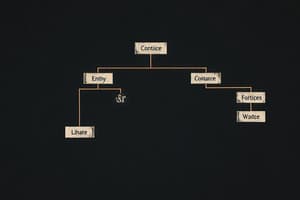Podcast
Questions and Answers
Cal é o propósito principal da normalización en bases de datos?
Cal é o propósito principal da normalización en bases de datos?
- Facilitar a inserción de datos duplicados.
- Complexificar o sistema de almacenamento de datos.
- Eliminar a redundancia e manter a integridade dos datos. (correct)
- Aumentar o tamaño dos datos almacenados.
Que significa 1FN na normalización?
Que significa 1FN na normalización?
- Que os datos están en forma de árbol.
- Que se permiten datos redundantes.
- Que só se permiten campos de texto.
- Que todos os atributos deben ser atómicos. (correct)
Cual é unha das características principais da 2FN?
Cual é unha das características principais da 2FN?
- Incrementar a redundancia de datos.
- Eliminar as dependencias parciais. (correct)
- Permitir varias claves primarias.
- Inclusión de datos especializados.
Que se busca alcanzar na terceira forma normal (3FN)?
Que se busca alcanzar na terceira forma normal (3FN)?
Se unha táboa está na 1FN, que se debería realizar para pasar á 2FN?
Se unha táboa está na 1FN, que se debería realizar para pasar á 2FN?
Cal é un erro común ao aplicar a normalización?
Cal é un erro común ao aplicar a normalización?
Que resultado busca a normalización en relación á integridade dos datos?
Que resultado busca a normalización en relación á integridade dos datos?
Que tipo de problemas pode causar a falta de normalización?
Que tipo de problemas pode causar a falta de normalización?
Flashcards
Normalización de datos
Normalización de datos
Unha forma de organizar datos en unha base de datos para evitar a redundancia e garantir a integridade dos datos. A normalización implica dividir os datos en diferentes táboas e relacionar as táboas usando claves.
Primeira forma normal (1FN)
Primeira forma normal (1FN)
Unha táboa está en primeira forma normal (1FN) se non ten grupos repetidos de datos. Cada columna debe ter un valor atómico, é dicir, un único valor indivisible.
Segunda forma normal (2FN)
Segunda forma normal (2FN)
Unha táboa está en segunda forma normal (2FN) se está en 1FN e elimina a dependência parcial. Cada atributo non chave depende completamente da chave principal.
Terceira forma normal (3FN)
Terceira forma normal (3FN)
Signup and view all the flashcards
Forma normal de Boyce-Codd (BCNF)
Forma normal de Boyce-Codd (BCNF)
Signup and view all the flashcards
Chaves foráneas
Chaves foráneas
Signup and view all the flashcards
Dependência funcional
Dependência funcional
Signup and view all the flashcards
Táboa normalizada
Táboa normalizada
Signup and view all the flashcards
Study Notes
Videotutorial 5: Database Fundamentals
- This videotutorial covers database normalization.
- The tutorial includes a complete exercise, Entity-Relationship (E-R) Model, Relational Model, and key normalization concepts.
- A summary of general concepts is also provided.
Exercise 1: Putting Theory into Practice
- The exercise involves creating an entity-relationship diagram and converting it into a relational model, following the first normal form.
- The exercise describes a database for a course with students and assignments (PACs).
- Each student has a unique ID, name, age, and languages spoken.
- Each PAC has a unique ID, number of questions, opening and closing dates, the number of days it is open, and the maximum score.
- Each question in a PAC is worth 0.2 points. This allows calculating the maximum score for each PAC.
Exercise 1 Diagram
- Shows the relationship between
ALUMNO,HACER, andPACtables. - The tables include attributes like
id_alu,edad,Nombre,nota,tiempo,id_pac,fecha_aper,dias_apertura,fecha_cierre,número_preg, andpuntuación_max.
ER & Normalized Diagram to 3NF
- The exercise showcases the normalization of tables to the third normal form (3NF).
- Shows the structure of the
ALUMNO,PAC,ALUMNO_PAC, andIDIOMAS_ALUMNOStables. - The
ALUMNOtable contains unique student identifiers. - The
PACtable includes data related to assignments. - The
ALUMNO_PACtable links students and assignments with attributes like the student's score and time spent on each assignment (PAC). - The
IDIOMAS_ALUMNOStable manages the languages a student knows.
Exercise 2: Normalizing a Table
- This exercise focuses on normalizing the
ALQUILEREStable. - The
ALQUILEREStable data is explained, includingFechaDeAlquiler (PK),CódigoLibroAlquilado (PK), andCódigoUsuario (PK) - The table includes multiple attributes like book title, editorial names, and user attributes.
- The tutorial highlights that a user can rent the same book multiple times.
- Updating user phone numbers and editorial locations proves problematic due to the data structure in the
ALQUILEREStable.
Normalization Solution (3NF)
- The solution shows the breakdown of the
ALQUILEREStable into multiple, interconnected tables. - This breakdown is done to improve data integrity and efficiency.
- The process of normalization is described.
- As a result the single original table is transformed into 6 tables that are interconnected.
Normal Forms (1NF, 2NF, 3NF)
- Explains how to eliminate multi-valued fields.
- Provides details on creating new tables to organize multi-valued attributes (e.g.,
TELEFONOS,AUTORES).
Normalization > 2NF
- Explains how the normalized data is further decomposed to resolve partial dependencies.
- This ensures that non-key attributes rely on the entire primary key.
ALQUILEREStable is further normalized. - Relationships are described with the inclusion of new tables like
LIBROS,EDITORIALES, andUSUARIOS.
Normalization > 3NF
- The video clarifies how
LIBROStable can be further normalized to eliminate transitive dependencies. - This step removes redundancy in the database.
- The solution explains the creation of a new table
EDITORIALES.
Summary of Normalization Process
- This section summarizes the process of converting a single table into multiple tables with better structure.
- Creating related tables to improve data accuracy and consistency is highlighted.
Contextualization
- This part of the tutorial discusses planning and developing a database, considering conceptual, logical, and physical levels.
- The different phases involved are explained, along with details about the database design, implementation choices, and efficiency.
Review Questions
- The presentation contains review questions on the concepts discussed.
- The questions include the creation of E-R diagrams for differing scenarios.
- There's a task to normalize, creating models from tables using 1NF, 2NF, and 3NF steps.
Conclusion
- Emphasizes the importance of database design considerations.
- The normalization process is demonstrated as a key concept in structuring efficient database systems.
Studying That Suits You
Use AI to generate personalized quizzes and flashcards to suit your learning preferences.
Related Documents
Description
Neste videotutorial abordarase a normalización de bases de datos. Inclúe un exercicio completo que presenta o Modelo de Entidade-Relación e o Modelo Relacional, así como os conceptos clave de normalización. Tamén se proporciona un resumo dos conceptos xenerais tratados no curso.




